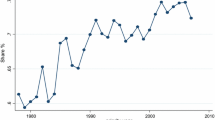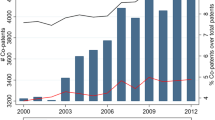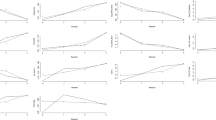Abstract
Patenting is often done in collaboration with other inventors to integrate complementary and additional knowledge. The paper takes a spatial view of this issue and analyses the distances between inventors of German patents. We compare the distances between invention teams of German patent applications from 1993–2006 and distinguish between academic and corporate teams and those consisting of researchers from both domains (‘mixed teams’). Due to their different institutional backgrounds different types of proximity guide their spatial search for partners. The basic finding is that regional collaboration clearly prevails. However, the distance between collaborating inventors of corporate patents exceeds that of inventors of academic patents, but the largest distances can be found in science–industry collaborative patents. When excluding directly neighboured collaboration, which is likely to be in-house collaboration, the differences between academic and corporate teams vanish, but mixed teams still overcome longer distances.



Similar content being viewed by others
Notes
We used a route planner to calculate the distances in order to take account of the real reachability. This approach is similar to the one used by Frenken et al. (2009). For distances exceeding the scope of the route planner (i.e. extra-Europe) an airline distance was estimated.
The thresholds of DistO-1 are selected by the following considerations: Less than 20 km working/living in the same city, below 50 km is still commuting distance, the next two categories reflect traveling by short-distance and long-distance train respectively, and the last two distance categories are traveled by short distance and medium-to-long distance flights respectively.
As mentioned in “Data” we had to include teams whose partners work for the same affiliation. We assume these collaborations to be those cases where inventors live <20 km apart (working in the same department or at least the same location of an organization). The short distance term of 20 km is a common commuter distance. According to the Statistical Office of Germany (STATmagazin 2009), in 2008 only 16.2 % of jobholders commuted more than 25 km.
References
Adams, J. D., Black, G. C., Clemmons, J. R., & Stephan, P. E. (2005). Scientific teams and institutional collaborations: evidence from US universities, 1981–1999. Research Policy, 34(3), 259–285.
Agrawal, A., Cockburn, I., & McHale, J. (2006). Gone but not forgotten: knowledge flows, labor mobility and enduring social relationships. Journal of Economic Geography, 6, 571–591.
Argyle, M. (1991). Cooperation. London: Routledge.
Aronson, E., Wilson, T. D., & Akert, R. M. (2009). Sozialpsychologie. München: Pearson Education.
Arrow, H., McGrath, J. E., & Berdahl, J. L. (2000). Small groups as complex systems. Thousand Oaks: Sage.
Aydalot, P. (1986). Milieux innovateurs en Europe. Discussion Paper. GREMI.
Bathelt, H., Malmberg, A., & Maskell, P. (2004). Clusters and knowledge: local buzz, global pipelines and the process of knowledge creation. Progress in Human Geography, 28(1), 31–56.
Berghoff, S., Federkeil, G., Giebisch, P., Hachmeister, C.-D., et al. (2009). Das CHE-Forschungsranking deutscher Universitäten 2009. Gütersloh: Centrum fuer Hochschulentwicklung.
Blind, K., Edler, J., Frietsch, R., & Schmoch, U. (2006). Motives to patent: empirical evidence from Germany. Research Policy, 35(5), 655–672.
Boschma, R. (2005). Proximity and innovation: a critical assessment. Regional Studies, 39(1), 61–74.
Boufaden, N., & Plunket, A. (2008). Proximity and innovation. Annales d’économie et de statistique, 87(88), 1–24.
Breschi, S., & Lissoni, F. (2001). Knowledge spillovers and local innovation systems: a critical survey. Industrial and Corporate Change, 10, 974–1005.
Breschi, S., & Lissoni, F. (2009). Mobility of skilled workers and co-invention networks: an anatomy of localized knowledge flows. Journal of Economic Geography, 4, 439–468.
Cohen, W. M., Florida, R., Randazzese, L., & Walsh, J. (1998). Industry and the academy. In: R. G. Noll (Ed.), Challenges to research universities. Washington, DC: Brookings Institutional Press.
Dasgupta, P., & David, P. A. (1994). Toward a new economics of science. Research Policy, 23, 487–521.
Davis, M. S. (1971). That’s interesting: towards a phenomenology of sociology and a sociology phenomenology. Philosophy of the Social Sciences, 1, 309–344.
Dutton, J. E., Bartunek, J. M., & Gersick, C. J. G. (1996). Growing a personal, professional collaboration. In J. P. Frost & M. S. Taylor (Eds.), Rhythms of academic life. Thousand Oaks: Sage.
Eden, L., Hitt, M. A., & Ireland, R. D. (2008). Friends, acquaintances or strangers? Partner selection in R&D alliances. Academy of Management Journal, 51(2), 315–334.
Fleming, L., Colfer, L., Marin, A., McPhie, J. (2003). Why the valley went first: agglomeration and emergence in regional inventor networks. Discussion Paper. Harvard Business School, Boston.
Fleming, L., Frenken, K. (2006). The evolution of inventor networks in the Silicon Valley and Boston regions. Discussion Paper. Utrecht University.
Frenken, K., Hoekman, J., Kok, S., Ponds, R., et al. (2009). Death of distance in science? A gravity approach to research collaboration. In A. Pyka & A. Scharnhorst (Eds.), Innovation networks: new approaches in modelling and analyzing. Berlin: Springer.
Frost, P. J., & Taylor, M. S. (1996). Rhythms of academia life. Thousand Oaks: Sage.
Gassmann, O., & von Zedtwitz, M. (1999). New concepts and trends in international R&D organization. Research Policy, 28(2–3), 231–250.
Gebert, D., & von Rosenstiel, L. (1996). Organisationspsychologie. Stuttgart: Kohlhammer.
Gittelman, M., & Kogut, B. (2003). Does good science lead to valuable knowledge? Biotechnology firms and the evolutionary logic of citation patterns. Management Science, 49(4), 366–382.
Goerzen, A. (2007). Alliance networks and firm performance: the impact of repeated partnerships. Strategic Management Journal, 28, 487–509.
Granovetter, M. (1983). The strength of weak ties: a network theory revisited. Sociological Theory, 1, 201–233.
Granovetter, M. (1985). Economic action and social structure: the problem of embeddedness. The American Journal of Sociology, 91(3), 481–510.
Guzzo, R. A., & Shea, G. P. (1992). Group performance and intergroup relations in organizations. In: M. D. Dunette & L. M. Hough (Eds.), Handbook of industrial and organizational psychology. Palo Alto: Consulting Psychologists Press.
Hagedoorn, J., Link, A. N., & Vonortas, N. S. (2000). Research partnerships. Research Policy, 29, 567–586.
Harhoff, D., Scherer, F. M., & Vopel, K. (2003). Citations, family size, opposition and the value of patent rights. Research Policy, 32(8), 1343–1363.
Hennemann, S., Rybski, D., Liefner, I. (2012). The myth of global science collaboration. Journal of Informetrics (forthcoming).
Hewitt-Dundas, N. (2012). The role of proximity in university-business cooperation for innovation. The Journal of Technology Transfer, Online first (forthcoming).
Hinings, C. R., & Greenwood, R. (1996). Working together. In J. P. Frost & M. S. Taylor (Eds.), Rhythms of academia life. Thousand Oaks: Sage.
Hoekman, J., Frenken, K., & Tijssen, R. J. W. (2010). Research collaboration at a distance: changing spatial patterns of scientific collaboration within Europe. Research Policy, 39(5), 662–673.
Hoekman, J., Frenken, K., van Oort, F. (2008). The geography of collaborative knowledge production in Europe. Discussion Paper. Università Commerciale ‘Luigi Bocconi’.
Howells, J. R. L. (2002). Tacit knowledge, innovation and economic geography. Urban Studies, 39(5–6), 871–884.
Hunt, J. G., Ropo, A., & Eriksson, P. (1996). Three voices reflecting on scholarly career journeys with international collaboration. In J. P. Frost & M. S. Taylor (Eds.), Rhythms of academia life. Thousand Oaks: Sage.
Jaffe, A. B., Trajtenberg, M., & Henderson, R. (1993). Geographic localization of knowledge spillovers as evidenced by patent citations. The Quarterly Journal of Economics, 108(3), 577–598.
Johnson, D. K. N., Siripong, A., & Brown, A. S. (2006). The demise of distance? The declining role of physical proximity for knowledge transmission. Growth and Change, 37(1), 19–33.
King, N. (1996). Innovation at work: the research literature. In M. A. West & J. L. Farr (Eds.), Innovation and creativity at work (clone): psychological and organizational strategies. Chichester: Wiley.
Kirat, T., & Lung, Y. (1999). Innovation and proximity: territories as loci of collective learning processes. European Urban and Regional Studies, 6(1), 27–38.
Kraut, R.E., Egidio, C., Galegher, J. (1988). Patterns of contact and communication in scientific research collaboration. Discussion Paper. Bell Communications Research, Inc. (Morristown) and University of Arizona.
Kraut, R. E., Galegher, J., & Egido, C. (1987). Relationships and tasks in scientific research collaboration. Human Computer Interaction, 1, 31–58.
Lahiri, N. (2010). Geographic distribution of R&D activity: how does it affect innovation quality? Academy of Management Journal, 53(5), 1194–1209.
Li, D. (2005). Knowledge protection and partner selection in R&D. PhD thesis. Texas A&M University.
Marshall, A. (1927). Industry and trade. A study of industrial technique and business organization, and their influences on the conditions of various classes and nations. London: Macmillan.
Narin, F., Stevens, K., & Whitlow, E. S. (1991). Scientific co-operation in Europe and the citation of multinationally co-authored papers. Scientometrics, 21(3), 313–323.
Payne, R. (1996). The effectiveness of research teams: a review. In M. A. West & J. L. Farr (Eds.), Innovation and creativity at work: psychological and organizational strategies. Chichester: Wiley.
Picci, L. (2009). The internationalization of inventive activity: a gravity model using patent data. Discussion Paper. University Library of Munich.
Ponds, R., van Oort, F., & Frenken, K. (2007). The geographical and institutional proximity of research collaboration networks. Papers in Regional Science, 86, 423–443.
Schmoch, U. (2007). Patentanmeldungen aus deutschen Hochschulen. Studien zum deutschen Innovationssystem No. 10-2007.
Schmoch, U., Laville, F., Patel, P., Frietsch, R. (2003). Linking Technology Areas to Industrial Sectors. Final Report to the European Commission. DG Research.
Singh, J. (2008). Distributed R & D, cross-regional knowledge integration and quality of innovative output. Research Policy, 37(1), 77–96.
STATmagazin (2009). Berufspendler nach der Entfernung zwischen Wohnung und Arbeitsstätte. http://www.destatis.de/jetspeed/portal/cms/Sites/destatis/Internet/DE/Grafiken/Publikationen/STATmagazin/Arbeitsmarkt/PendlerJahresvergleich. Accessed 24 June 2011.
Trajtenberg, M., Henderson, R., & Jaffe, A. (1997). University vs. corporate patents: a window on the basicness of invention. Economics of Innovation and New Technology, 5, 19–50.
Wagner, C. S., & Leydesdorff, L. (2005). Mapping the network of global science: comparing international co-authorships from 1990 to 2000. International Journal of Technology and Globalisation, 1(2), 185–208.
Wagner-Doebler, R. (2001). Continuity and discontinuity of collaboration behaviour since 1800: from a bibliometric point of view. Scientometrics, 52(3), 503–517.
Williamson, O. E. (1981). The economics of organizations: the transaction cost approach. American Journal of Sociology, 87, 548–577.
Wuchty, S., Jones, B. F., & Uzzi, B. (2007). The Increasing dominance of teams in production of knowledge. Science, 316(5827), 1036–1039. doi:10.1126/science.1136099.
Author information
Authors and Affiliations
Corresponding author
Appendix
Appendix
Rights and permissions
About this article
Cite this article
von Proff, S., Dettmann, A. Inventor collaboration over distance: a comparison of academic and corporate patents. Scientometrics 94, 1217–1238 (2013). https://doi.org/10.1007/s11192-012-0812-8
Received:
Published:
Issue Date:
DOI: https://doi.org/10.1007/s11192-012-0812-8




